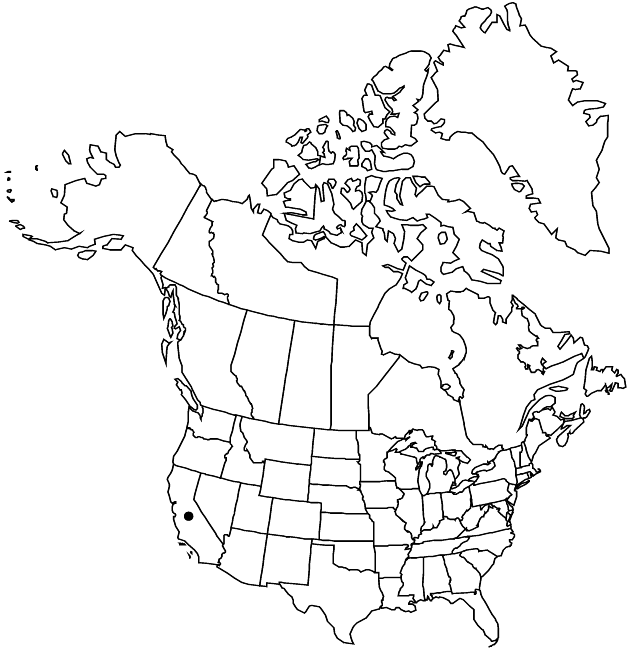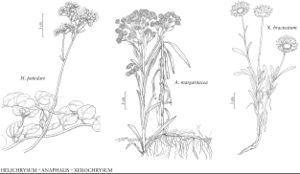Difference between revisions of "Helichrysum petiolare"
Notes Roy. Bot. Gard. Edinburgh 32: 357. 1973.
FNA>Volume Importer |
imported>Volume Importer |
||
| (5 intermediate revisions by 2 users not shown) | |||
| Line 24: | Line 24: | ||
|elevation=300–600 m | |elevation=300–600 m | ||
|distribution=Calif.;s Africa (Cape region);introduced in Europe. | |distribution=Calif.;s Africa (Cape region);introduced in Europe. | ||
| + | |introduced=true | ||
|discussion=<p>The species is included among the invasive species of California (C. C. Bossard et al. 2000); it is native to the Cape region of South Africa, long cultivated in Europe, and now widely offered for sale on the internet. In contrast to the assessment of invasiveness in California, one commercial website selling the species notes this “forms tangled mounds of trailing grey-felted leaves. Given something to scramble up, it will climb. And although this description makes it sound fairly rampant, it is definitely not invasive.” It is often recommended for planters and hanging baskets, where the silvery leaves provide backdrop for bright colors.</p><!-- | |discussion=<p>The species is included among the invasive species of California (C. C. Bossard et al. 2000); it is native to the Cape region of South Africa, long cultivated in Europe, and now widely offered for sale on the internet. In contrast to the assessment of invasiveness in California, one commercial website selling the species notes this “forms tangled mounds of trailing grey-felted leaves. Given something to scramble up, it will climb. And although this description makes it sound fairly rampant, it is definitely not invasive.” It is often recommended for planters and hanging baskets, where the silvery leaves provide backdrop for bright colors.</p><!-- | ||
--><p>The name <i>Helichrysum</i> petiolatum D. Don has been misapplied to plants of <i>H. petiolare</i>.</p> | --><p>The name <i>Helichrysum</i> petiolatum D. Don has been misapplied to plants of <i>H. petiolare</i>.</p> | ||
| Line 34: | Line 35: | ||
-->{{#Taxon: | -->{{#Taxon: | ||
name=Helichrysum petiolare | name=Helichrysum petiolare | ||
| − | |||
|authority=Hilliard & B. L. Burtt | |authority=Hilliard & B. L. Burtt | ||
|rank=species | |rank=species | ||
| Line 50: | Line 50: | ||
|publication year=1973 | |publication year=1973 | ||
|special status= | |special status= | ||
| − | |source xml=https:// | + | |source xml=https://bitbucket.org/aafc-mbb/fna-data-curation/src/2e0870ddd59836b60bcf96646a41e87ea5a5943a/coarse_grained_fna_xml/V19-20-21/V19_702.xml |
|tribe=Asteraceae tribe Gnaphalieae | |tribe=Asteraceae tribe Gnaphalieae | ||
|genus=Helichrysum | |genus=Helichrysum | ||
Latest revision as of 20:54, 5 November 2020
Shrubs or subshrubs, aromatic, to 60 cm. Stems loosely branched, straggling. Leaves petiolate; blades ovate, 1–2 cm, apices obtuse to subacute, faces concolor, silvery green, woolly-tomentose. Phyllaries creamy white.
Phenology: Flowering summer.
Habitat: "Shrubby plants forming a dense thicket on the slope of Bolinas Ridge above Stinson Beach" (J. T. Howell 1970)
Elevation: 300–600 m
Distribution

Introduced; Calif., s Africa (Cape region), introduced in Europe.
Discussion
The species is included among the invasive species of California (C. C. Bossard et al. 2000); it is native to the Cape region of South Africa, long cultivated in Europe, and now widely offered for sale on the internet. In contrast to the assessment of invasiveness in California, one commercial website selling the species notes this “forms tangled mounds of trailing grey-felted leaves. Given something to scramble up, it will climb. And although this description makes it sound fairly rampant, it is definitely not invasive.” It is often recommended for planters and hanging baskets, where the silvery leaves provide backdrop for bright colors.
The name Helichrysum petiolatum D. Don has been misapplied to plants of H. petiolare.
Selected References
None.
